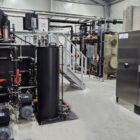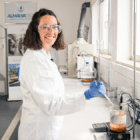The redox voltage, often used synonymously with the redox potential, is an essential parameter in industrial water and wastewater treatment. It describes the electrochemical state of a system in relation to the electron transfer reactions between oxidizing and reducing substances. Unlike the redox potential, which is measured in the context of the reference electrode, the redox voltage often refers to the difference between the oxidation and reduction processes within a system. It is measured in millivolts (mV) and is a direct measure of the ability of a medium to release or accept electrons.
Table of contents
Fundamentals of redox voltage
Oxidation and reduction processes
The redox voltage is based on redox reactions in which electrons are transferred between molecules or ions. Two partial reactions always occur:
- Oxidation: electrons are released.
- Reduction: Electrons are absorbed.
The redox voltage is a measure of the electrochemical balance of these processes. It describes the driving force with which electrons flow from a reducing agent (electron donor) to an oxidizing agent (electron acceptor). The higher the redox voltage, the stronger the oxidizing force of the medium; if the redox voltage is low, the reducing force dominates.
Electrochemical measurement
The redox voltage is measured according to the principles of electrochemistry. A measuring electrode (e.g. made of platinum or gold) is inserted into the medium. This electrode interacts with the redox pairs in the water. A reference electrode (e.g. silver/silver chloride or calomel electrode) is used for the measurement to ensure a stable comparison potential.
The redox potential depends on factors such as the concentration of the redox pairs, the temperature and the pH value. The measurement must therefore be carried out under controlled conditions in order to obtain comparable values.
Practical significance of redox voltage in water and wastewater technology
1. disinfection
In water treatment, the redox potential is often used to monitor disinfection, especially when using chlorine, ozone or hydrogen peroxide. A high redox potential (e.g. > 650 mV) indicates sufficient oxidizing power, which is necessary to kill germs and pathogens.
- Example of chlorine:
When using chlorine, the redox potential is an indicator of the disinfection performance. Chlorine oxidizes organic compounds and microorganisms, which increases the redox potential.
2. oxidation of pollutants
The redox potential is used in the Fenton reaction, in which iron(II) salts and hydrogen peroxide react to produce hydroxyl radicals (OH-). These radicals oxidize organic pollutants very efficiently.
- Typical target: Degradation of organic substances that are difficult to break down (e.g. in pharmaceutical or chemical wastewater).
3. precipitation and reduction of chromium(VI) to chromium(III) with sodium bisulfite
The reduction of chromium(VI) to chromium(III) in industrial waste water is a special field of application for redox voltage. Chromium(VI) is a highly toxic and carcinogenic heavy metal that occurs in many processes, for example in metal processing or surface treatment. In order to comply with legal limits, chromium(VI) is often reduced by sodium bisulphite (NaHSO₃).
Reaction mechanism:
Sodium bisulphite acts as a reducing agent that converts chromium(VI) in an acidic solution into the less toxic and more easily precipitated form chromium(III).
- Chromate ions (Cr₂O₇²-) are converted into chromium(III) ions (Cr³⁺) by electron transfer.
- Protons (H⁺) from the acidic solution support the reduction.
- The resulting chromium(III) can then be removed from the water by precipitation as chromium hydroxide (Cr(OH)₃).
Redox potential monitoring:
The redox potential is a key parameter in this process, as it reflects the effectiveness of the reduction:
- Ein niedriges Redoxpotential (< +200 mV) zeigt an, dass genügend Reduktionsmittel vorhanden ist und die Reaktion in Richtung Chrom(III) verläuft.
- Rising redox values indicate that the reduction is incomplete or that additional dosing of sodium bisulphite is required.
Practical implementation:
In practice, sodium bisulphite is dosed in an oxygen-free, highly acidic environment (pH 2-3) to ensure efficient and complete reduction. The resulting chromium(III) is precipitated as insoluble chromium hydroxide by raising the pH to 7-9 and can be removed by sedimentation or filtration.
This process combines chemical dosing, redox potential monitoring and precipitation processes and ensures safe and compliant wastewater treatment.
4. biological wastewater treatment
The redox potential is an important parameter in biological wastewater treatment as it reflects the activity of microorganisms:
- Aerobic processes: High redox values (> 200 mV).
- Anaerobe Prozesse: Niedrige Redoxwerte (< -200 mV).
Targeted monitoring of the redox voltage helps to optimize the processes and protect the system from undesirable biological reactions (e.g. sulphate reduction or methane formation).

Photo: Our CP system ALMA CHEM MCW with sodium bisulphite dosing for the reduction of chromium VI
Factors influencing the redox voltage
Concentration of redox pairs
A change in the concentration of the oxidized or reduced species leads to a shift in the redox potential. An increase in the concentration of the oxidizing agent (e.g. ozone) increases the value.
pH value
As many redox reactions depend on protons (H⁺), the pH value influences the redox potential. For example, an alkaline medium shifts the oxidation reactions of oxygen.
Temperature
As the temperature rises, the kinetic energy of the molecules increases, which increases the reaction rate and thus the redox potential.
Presence of impurities
Dissolved organic substances or salts can influence the redox reactions either by being oxidized/reduced themselves or by triggering side reactions.
Measurement and control in practice
In industrial plants, the redox voltage is often measured online using robust electrodes that are integrated directly into the process streams. The measured values serve as the basis for the automated control of chemical dosing and processes. Examples
- Dosing of oxidizing agents: Optimum addition of chlorine or ozone for disinfection.
- Monitoring of anaerobic reactors: Ensuring stable process conditions by monitoring the redox level.
- Corrosion protection in cooling circuits: Avoidance of corrosive conditions by controlling the redox voltage.
Conclusion
The redox voltage is an indispensable parameter in industrial water and wastewater technology. It allows the precise monitoring and control of chemical and biological processes and provides essential information about the condition of a system. A sound understanding of the redox potential and its influencing factors enables engineers to significantly increase the efficiency and safety of water and wastewater treatment plants.
For further information on our products, please feel free to contact us at any time!








